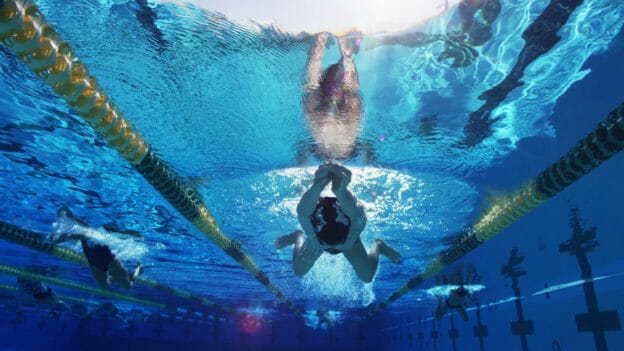Adam Peaty’s Secret: Fast Kicking Cycle
In a recent SwimSwam article, Stefano Nurra does a nice job of analyzing the nuances of breaststrokers’ techniques, including Adam Peaty. Stefano breaks down the pulling cycle into three phases and the kicking cycle into four phases, defining each phase. Stefano ascribes Peaty’s secret to success to his longer percentage of time spent in the streamlined glide phase of his stroke, and he is right.I believe Adam Peaty’s secret is the fast kicking cycle.
I know what you are probably thinking, Peaty doesn’t glide for very long. If so, you are right. Peaty is famous not only for his fast times but also for his high stroke rate. Remember that Stefano is referring to the percentage of time, not absolute time. But that is still important.
There are two points of acceleration during a single breaststroke cycle, one from the kick and one from the pull, which leads to two peak velocities. After the pull peak velocity, every swimmer’s velocity will drop to zero or nearly to zero. The big thighs drawing forward and the upper body and shoulders rising up out of the water result in a swimmer causing the worst drag coefficient imaginable. That is a necessary evil to put the swimmer into the best position for the strongest kicking propulsion which follows. It is why I call breaststroke the standing dunk of swimming strokes. The swimmer must start each kick from virtually a dead stop.
What happens after the kick, however, is a very different story. Using Velocity Meter (VM) technology, we have learned that there are huge differences in the accelerations and peak velocities achieved from the kick, the kicking cycle times, and the percentage of loss of velocities after the kick, during the glide phase of the cycle. The peak accelerations and subsequent peak velocities are related to the amount of propulsion achieved from the kick. The kicking cycle time affects both the amount of propulsion and the amount of drag resulting from the kick. The percentage loss of velocity after the kick reflects the swimmer’s ability to streamline both ends of the body well during this phase, to hold speed. Recently, we released a great video on how to finish the breaststroke kick properly to help sustain that speed, available to Lanes 3 and 4 for our subscribers.
To determine the kicking cycle time with VM technology, we measure the time precisely between the peak acceleration from the pull and the peak acceleration from the kick. Those two peak accelerations correlate precisely with the peak propulsion times from the pull and kick respectively. In our recently released book, Fundamentals of Fast Swimming, we describe and show exactly how this is done. This is where Adam Peaty and Lilly King stand out. Not only do they get tremendous propulsion from their kicks, but they spend less time doing it. That means they spend more time in the more desirable streamline or glide position.
There is another really important reason why a fast kicking cycle in breaststroke is very critical. That reason has to do with coupling motions. An entire article will be devoted to the techniques and capabilities that result in great breaststroke kick propulsion. One of the factors in determining that propulsion is a strong coupling. The coupling for the breaststroke kick comes from the upper body and head moving downward and forward after the pull. The kinetic energy in those motions will augment the propulsion from the kick if the two are timed correctly. That is a BIG if.
Most of the time they are not. A swimmer who elevates his or her shoulders high out of the water before the kick has approximately .5 seconds to get the legs through the kicking cycle to peak propulsion. That is not a lot of time. While I have never measured Adam nor Lilly with VM technology, I would guess that both are under .5 seconds. Stefano’s data agrees with that presumption.
The breaststroker who can generate a lot of energy with the upper body and head coming down and can then harness that energy into their kicking propulsion has a huge advantage. That ability depends on having a fast kicking cycle time. Once the swimmer’s body reaches the water, the kinetic energy of that motion goes to nearly zero very quickly. If the swimmer’s kick is not in the peak propulsion phase exactly when the kinetic energy of the moving body is greatest, as it strikes the water, the kick propulsion will be less.
To summarize, there is a lot at stake with a swimmer’s breaststroke kicking cycle speed: propulsion and coupling, drag, and the potential top stroke rate. To build a faster, more powerful breaststroke like Adam and Lilly have, start working on your breaststroke kicking cycle speed.
Yours in Swimming,
Gary Sr.
For the Most Advanced Swimming Technique Videos

